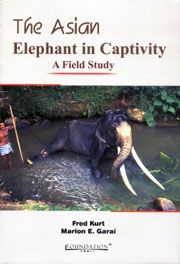Book contents
- Frontmatter
- Contents
- Preface
- Acknowledgments
- 1 Introduction
- 2 The Sri Lankan Elephant
- 3 The Captive Populations, Keeping Systems and Health
- 4 Food, Tool Use and Sleep
- 5 Musth, Reproduction, Social Integration and Stereotypy
- 6 Captive Elephants and Conservation
- 7 Base Lines and Proposals
- Appendix I
- Appendix II
- References
- Photo Gallery
- Index
Preface
Published online by Cambridge University Press: 05 February 2012
- Frontmatter
- Contents
- Preface
- Acknowledgments
- 1 Introduction
- 2 The Sri Lankan Elephant
- 3 The Captive Populations, Keeping Systems and Health
- 4 Food, Tool Use and Sleep
- 5 Musth, Reproduction, Social Integration and Stereotypy
- 6 Captive Elephants and Conservation
- 7 Base Lines and Proposals
- Appendix I
- Appendix II
- References
- Photo Gallery
- Index
Summary
Once upon a time the Raja of Savatthi called his servant and said: “Go and gather together in one place all the men of the capital who were born blind and show them an elephant”. The servant did as he was told. To one blind man he presented one ear of the elephant, to anther its trunk, to another a foreleg, to the other three either the belly, the tail or the tuft of the tail. When the six blind men had felt the elephant, the Raja asked each of them: “Tell me, what sort of thing is an elephant?” Thereupon the man who was still holding the ear answered: “Sir, an elephant is like a fan”. The others said that the elephant was like a tube, a pillar, a wall, a rope or a brush. Now illuminated, the blind men no longer needed to beg. With such specialised knowledge they were qualified to establish a school of elephantology. The whole world would beat a path. But how to present to that world the arcane laws of elephantology? A fan, a tube, a pillar, a wall, a rope, a brush? They meditated, they discussed. Chaos resulted. Cooperation was impossible.
Based on the idea of the Canadian writer, Patricia Kathleen Page, this is a new version of an old Buddhist canon about human ignorance. Each of the sight-challenged experts, mistakes the parts for the whole, just as today adherents of different elephant management practices, students of different scientific disciplines engaged with the life of captive elephants or representatives of animal welfare organisations claim a firm hold on truth, while disparaging or ignoring other findings and opinions.
- Type
- Chapter
- Information
- The Asian Elephant in CaptivityA Field Study, pp. v - viPublisher: Foundation BooksPrint publication year: 2006

